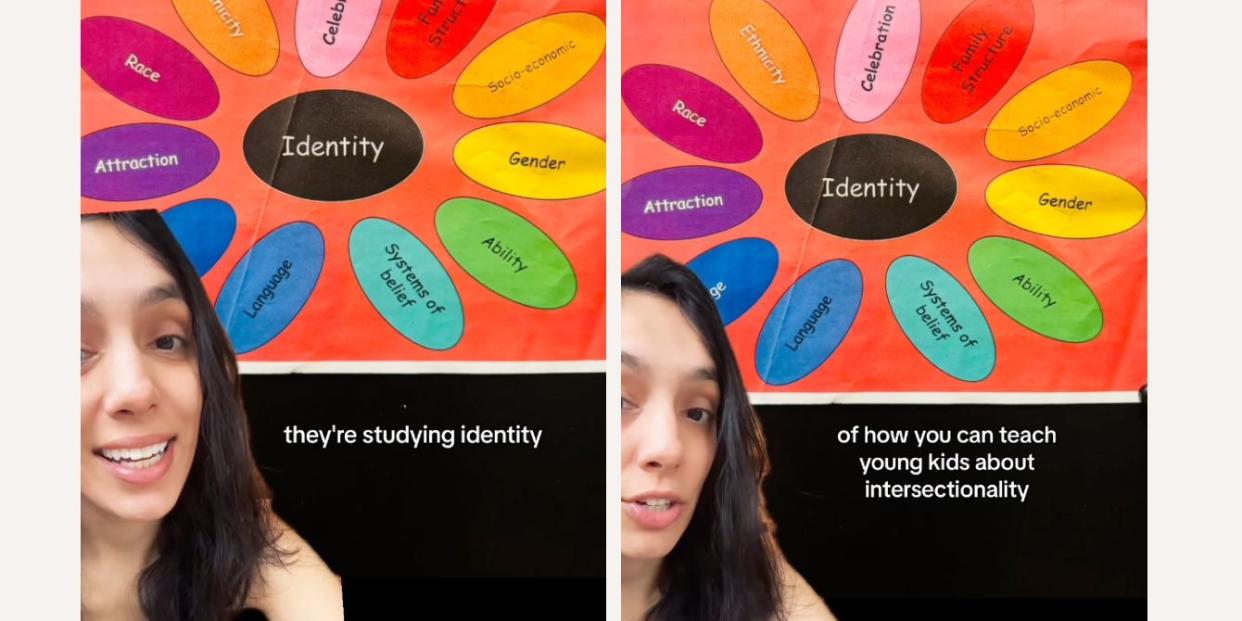Therapist and mom shares genius way for kids to learn about identity at a young age

Dr. Pria Alpern, a trauma therapist and EMDR consultant shared an incredibly important (and surprisingly easy) way to help teach our children about identity, and she was inspired by her 5-year-old child’s chart about identity, which she brought home from school. She noted it was a “brilliant way” to get kids started in understanding all about identity.
As something that most adults still struggle with, this chart can be super helpful to lay the groundwork for children learning about themselves as individuals and about intersectionality, ensuring they have confidence, a strong sense of self, and how their contributions are important within the community, as well as celebrating differences. Topics the grownups of this world could use a lot more understanding of, to be honest.
She explained the chart: There’s identity at the center and you have all the facets surrounding identity that comprise you as a person. It’s really not that hard, Dr. Alpern explained. The different facets of what makes up someone’s identity, according to the chart, included “Ethnicity,” “Celebration,” “Family Structure,” “Socio-Economics,” “Gender,” “Ability,” “Systems of Belief,” “Language,” “Age,” “Attraction,” and “Race.”
Dr. Alpern listed sub-topics on her Instagram post that parents can use to help children learn about identity and intersectionality, including “Exploring Names and Families,” “Colors and Cultures,” “Interests and Talents,” Respecting Differences,” “Feelings and Empathy,” “Gender Awareness,” “Community Helpers,” “Books and Stories,” and “Celebrating Similarities and Differences.”
Under “Exploring Names and Families,” she advised parents to “discuss different names and family structures, highlighting that everyone is different, and to share stories about diverse families to show there are various ways for people to come together.”
Introducing the concept of skin colors in a positive way, and emphasizing the beauty of diversity is one way to discuss the “Colors and Cultures” section, according to Dr. Alpern. She also suggested talking about different cultural traditions and “how they contribute to the rich tapestry of our world.”
Every child has different interests and talents they can bring to the world, and that is something parents should discuss with their children by having them share their own favorite activities and what they’re good at. “Emphasize that each person has special skills and interests that make them who they are,” Dr. Alpern said about discussing “Interest and Talents” with your children.
Dr. Alpern suggested teaching the importance of respecting and valuing differences in others, and using simple examples of how differences make our community stronger when discussing the “Respecting Differences” section.
As for “Gender Awareness,” she said that parents can introduce the idea that people can have different gender identities and it’s okay to like different things, regardless of one’s gender identity.
For the “Community Helpers” section, Dr. Alpern suggested parents should “Highlight different jobs and roles in the community to show the variety of ways people contribute, and reinforce that everyone plays an important part in making our communities work.” May I also suggest the Daniel Tiger episode about finding the helpers during times of crisis? Thank you, Mr. Rogers.
Of course, reading diverse books and stories that feature characters from various backgrounds is an awesome idea when teaching identity and intersectionality. “Use literature to spark conversations about different experiences and perspectives,” Dr Alpern noted.
She also noted that encouraging children to celebrate both what makes them unique and what they have in common with others was crucial when learning about identity, and emphasizing the importance of being kind and including everyone, regardless of differences.
“Model inclusive behavior and praise children for acts of kindness,” she concluded.
If you don’t want to hurt your own feelings and feel like we live in a pit of despair, I recommend not looking at the comments of the original Instagram video. But you will see a shining example of why identity and intersectionality are desperately needed to be taught in school, with parents continuing to nurture these concepts at home.

